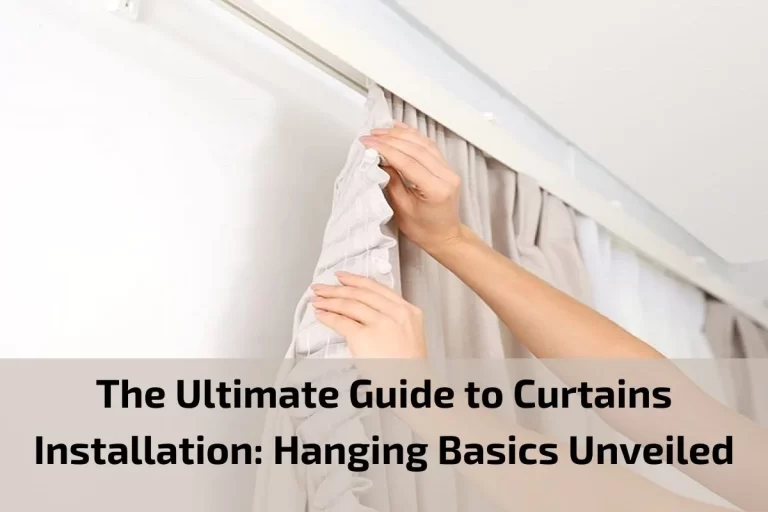Selecting the perfect curtain brackets is a crucial step in transforming your windows from mere functional elements to stylish focal points of your living space. While curtains add warmth, texture, and personality to a room, the right curtain brackets play an equally important role in supporting and enhancing the overall aesthetic. In this guide, we will delve into the world of curtain brackets, exploring the diverse styles, materials, and considerations that go into making an informed choice. Whether you’re aiming for a classic, contemporary, or eclectic look, understanding the nuances of curtain brackets will empower you to make decisions that not only elevate your window décor but also contribute to the overall ambiance of your home. Join us on this journey as we navigate through the intricacies of choosing the right curtain brackets to complement and complete your interior design vision.
When it comes to window décor, it’s easy to focus on the curtains, drapes, or blinds themselves, overlooking the crucial role that curtain brackets play in the overall aesthetic and functionality. Curtain brackets are not just functional hardware; they are a subtle yet significant element that can enhance the style, support, and overall appeal of your window treatments.
The Importance of curtain brackets in window décor
Curtain brackets may often be overlooked in the realm of window décor, but their significance is undeniable, playing a pivotal role in both functionality and aesthetics. These seemingly small and utilitarian pieces of hardware serve as the unsung heroes, providing essential support for your curtains or drapes while contributing to the overall visual appeal of your living space.
Structural Support:
Curtain brackets are the structural backbone of any window treatment. Their primary function is to bear the weight of curtains, ensuring they hang evenly and smoothly. Well-designed brackets offer stability, preventing sagging and maintaining the integrity of your chosen window coverings.
Aesthetic Enhancement:
Beyond their practical purpose, curtain brackets contribute to the overall aesthetic of your window décor. Available in a myriad of styles, materials, and finishes, brackets can be chosen to complement or accentuate the design theme of your room. Whether your preference is for sleek modern lines, classic elegance, or rustic charm, the right brackets can tie together the entire look.
Variety of Styles and Materials:
Curtain brackets come in a diverse range of styles and materials, allowing homeowners to personalise their window treatments. From ornate and decorative brackets that become focal points to minimalistic options that seamlessly blend into the background, the choices are vast. Common materials include sturdy metals like iron or stainless steel and the warmth of wooden brackets, each offering unique visual appeal.
Adaptability to Window Configurations:
Different window types demand different bracket solutions. Bay windows, French doors, or unconventional architectural designs all require specialised bracket styles to ensure proper functionality and an aesthetically pleasing appearance. The adaptability of curtain brackets to various window configurations makes them a versatile and essential element in window décor.
Coordination with Rods and Finials:
Achieving a cohesive and polished look for your window treatments involves careful coordination between curtain brackets, rods, and finials. Matching these elements harmoniously contributes to a seamless visual presentation, elevating the overall design of your windows and the room as a whole.
Types of Curtain Brackets
Single Curtain Brackets:
- Ideal for windows that require only one curtain panel.
- Simple and straightforward, these brackets provide a clean and minimalist look.
Double Curtain Brackets:
- Designed for windows where you want to hang two curtain panels, such as for layering curtains.
- Consists of two sets of brackets to support both curtains separately.
Adjustable Curtain Brackets:
- Perfect for windows of varying widths.
- These brackets can be adjusted to accommodate different curtain rod lengths, providing flexibility in installation.
Ceiling-Mounted Brackets:
- Installed on the ceiling rather than the wall.
- Ideal for creating a modern and streamlined look, especially in rooms with high ceilings.
Wall-Mounted Brackets:
- The traditional and most common type of curtain bracket.
- Installed on the wall around the window frame to support the curtain rod.
Inside Mount Brackets:
- Positioned inside the window frame.
- Suitable for windows with limited wall space around the frame.
Outside Mount Brackets:
- Installed on the wall outside the window frame.
- Useful for windows that require extra coverage or for creating an illusion of larger windows.
Swivel Brackets:
- Designed to allow the curtain rod to pivot.
- Useful for windows with irregular shapes or for creating dynamic curtain arrangements.
Corner Brackets:
- Specifically crafted for corner windows.
- Enables smooth and continuous curtain rod installation around corners without interruption.
Decorative Brackets:
- Embellished with decorative elements like finials, intricate designs, or unique finishes.
- Functionality meets aesthetics, making them a focal point in the overall window treatment design.
Café Curtain Brackets:
- Short brackets designed for café curtains, typically covering only the lower part of the window.
- Offers privacy without obstructing the view.
Tension Rod Brackets:
- Designed for tension rods, eliminating the need for drilling or permanent installation.
- Ideal for temporary or rental spaces.
Choosing the Right Curtain Brackets
Choosing the right curtain brackets is a crucial step in achieving the perfect window treatment for your home. Beyond their functional role in supporting curtains, brackets contribute significantly to the overall aesthetics of your living space. Here’s a comprehensive guide to help you navigate the process of selecting the ideal curtain brackets:
Consider Window Type and Configuration:
- Assess the type of windows you have (e.g., standard, bay, corner) to determine the most suitable bracket style.
- Different window configurations may require specific bracket types for optimal support and a polished look.
Understand Single vs. Double Brackets:
- Determine whether your window treatment requires one or two curtain panels.
- Single brackets are ideal for windows with a single curtain, while double brackets accommodate two panels for a layered or coordinated look.
Explore Bracket Materials:
- Choose bracket materials that align with your design preferences and the overall theme of the room.
- Common materials include metal (such as iron or stainless steel) for a contemporary feel, or wood for a warmer, classic touch.
Match Brackets with Curtain Rods and Finials:
- Ensure a cohesive appearance by coordinating brackets with the curtain rod and finials.
- Consistent styling across these elements contributes to a harmonious and well-designed window treatment.
Consider Adjustable Brackets:
- opt for adjustable brackets if you have varying window widths.
- Adjustable brackets provide flexibility, allowing you to customise the curtain rod’s length for a precise fit.
Determine Mounting Options:
- Choose between ceiling-mounted and wall-mounted brackets based on your aesthetic preferences and the architectural features of your space.
- Ceiling-mounted brackets create a modern, sleek look, while wall-mounted brackets are a traditional choice.
Take Note of Curtain Weight:
- Consider the weight of your curtains when selecting brackets to ensure they can adequately support the fabric.
- Heavier curtains may require sturdier brackets to prevent sagging over time.
Factor in Decorative Elements:
- Explore decorative brackets with embellishments, unique finishes, or intricate designs to add a touch of style to your window treatment.
- Decorative brackets can serve as eye-catching accents, elevating the overall visual appeal of the space.
Evaluate Budget-Friendly Options:
- Determine a budget for your window treatment project and explore cost-effective bracket options that align with your financial constraints.
- Affordable brackets can still offer durability and style without compromising quality.
Seek Professional Advice if Needed:
- If you’re uncertain about which brackets to choose, consult with professionals or seek advice from home improvement experts.
- Professionals can provide guidance based on your specific window dimensions and design goals.
Step-by-Step Installation Guide of Curtain Brackets
Installing curtain brackets is a straightforward process, and with a few basic tools, you can have your window treatments up in no time. Here’s a step-by-step guide to help you with the installation of curtain brackets:
Materials Needed:
- Curtain brackets
- Curtain rod
- Level
- Measuring tape
- Pencil
- Screwdriver or drill
- Screws (provided with the brackets)
Gather Your Materials
- Before you begin, ensure that you have all the necessary materials and tools at hand. Lay out the curtain brackets, the curtain rod, the level, measuring tape, pencil, screwdriver or drill, and the screws that came with the brackets.
Measure and Mark Placement
- Start by measuring the desired height for your curtain rod above the window frame. Typically, brackets are installed about 4 to 6 inches above the window frame to create an illusion of height.
- Use the measuring tape and pencil to mark the placement of the brackets on both sides of the window. Ensure the marks are level to guarantee a straight and balanced installation.
Position the Brackets
- Hold one bracket against the marked spot on the wall. Align the bracket with the pencil mark and ensure it is level.
- Once positioned correctly, use the pencil to mark the screw holes on the wall.
- Repeat the process for the second bracket on the opposite side of the window.
Pre-Drill Holes
- If you are using a drill, choose a drill bit that matches the size of the screws provided with the brackets.
- Carefully drill pilot holes into the marked spots on the wall. Be mindful of the depth to avoid damaging the wall.
Attach the Brackets
- Place the brackets back against the wall, aligning them with the drilled holes.
- Secure the brackets to the wall using the screws provided. If using a drill, be cautious not to overtighten, as it may strip the screw holes.
Mount the Curtain Rod
- Slide the curtain rod through the openings in the brackets.
- Ensure that the rod is level by using a bubble level. Adjust the brackets if necessary.
Secure the Finials (If Applicable)
- If your curtain rod has finials (decorative end pieces), secure them in place according to the manufacturer’s instructions.
Hang Your Curtains
- Once the curtain rod is securely in place, hang your curtains onto the rod and adjust them as needed.
Conclusion
By carefully considering factors such as window type, bracket style, materials, and coordination with other elements like curtain rods and finials, you can make informed decisions that align with your design preferences and practical needs. Whether you opt for decorative brackets that double as artistic accents or choose understated, functional options, the right curtain brackets can transform your windows into focal points within your home.








